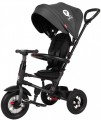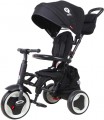Max. weight
The maximum rider weight that the bike can normally carry. This point is directly related to the age group (see above), however, bikes with the same age recommendations may differ in maximum load.
Of course, it is impossible to exceed the load specified by the manufacturer: even if an accident does not happen immediately, it can happen at any time. And ideally, you should choose a bike with a margin of weight — both in case of emergency situations, and taking into account the fact that the child will grow.
Frame material
—
Steel. A fairly common material, widely used in all types of children's bicycles (see "Type"). Although inexpensive, steel is very durable, reliable, and resistant to impacts and shocks. Many consider its main drawback to be its relatively large weight; however, the difference in weight with the same aluminum is usually not that great (especially compared to the weight of the cyclist). It is worth noting that different grades of steel can be used in children's bicycles, and the overall quality of this material often depends on the price category of the machine.
—
Aluminum. Aluminum-based alloys are very strong, weigh little, and are also much less susceptible to corrosion than steel. On the other hand, the cost of such materials is significantly higher, and high strength is not always critical (considering the peculiarities of riding children's bicycles, especially three-wheeled ones). Therefore, aluminum is less common, although it can also be used in all types of machines.
—
Plastic. Plastic is relatively light in weight, completely insensitive to moisture and easy to process — it can be given almost any shape and color. At the same time, this material is inexpensive. On the other hand, plastic is not durable; therefore, it is used exclusively in bicycles for the smallest, mainly in three-wheeled models and balance bikes (see "Type").
—
...href="/list/604/pr-9552/">Wood. The general characteristics of wood are such that this material is poorly suited for classic bicycles — both two- and three-wheeled — but is very convenient for balance bikes (see "Type"). Wood, even unpainted, looks good, and this material is quite pleasant to the touch. Its disadvantages include some fragility — while the same plastic is likely to bend from a strong impact, wood can crack. However, it is still difficult to damage a wooden balance bike frame. But such a product does not tolerate moisture well, so it should be stored in a dry place.
— Fiberglass. As a rule, in this case it is not pure fiberglass that is meant, but fiberglass — a composite material made of glass fiber filled with plastic filler. This material is noticeably stronger than regular plastic, but it is also more expensive, and in terms of overall reliability it still does not reach the level of steel and aluminum. Therefore, fiberglass frames are quite rare, and mainly among balance bikes (see "Type").
— Magnesium. Magnesium alloys are similar to the aluminum alloys described above: they are highly durable and lightweight. At the same time, compared to aluminum, this alloy is stronger and more durable, weighs more, but not much, but costs significantly more — and the difference in price rarely outweighs the advantages mentioned. As a result, magnesium frames are not very widespread; they are found only in certain models of two-wheeled bicycles of the older age group.Wheels
The design of the wheels fitted to a bicycle and the materials used for the tyre/rim.
—
Inflatable rubber. Wheels with inflatable rubber tires — the same as those on full-size adult bicycles. Such wheels are quite demanding in terms of maintenance: their condition must be monitored and pumped up if necessary. In addition, even a small puncture in the tire makes it unusable and requires repair. On the other hand, this is the most advanced type of wheel in terms of performance: they perform well even on uneven roads, smooth out vibrations, provide good traction and are suitable for fast, dynamic riding. And servicing inflatable tires can be a good training for a young cyclist before switching to a teenage bike. That is why two-wheeled models for older age groups are mainly equipped with inflatable tires. However, this option can also be found in other varieties, including balance bikes and even three-wheeled ones (see "Type").
—
Rubber. Wheels with a solid rubber tire. Unlike the inflatable ones described above, such tires do not need to be inflated, and they are completely resistant to scratches and punctures. On the other hand, solid rubber wheels are less suitable for uneven roads and high loads. Therefore, they are found mainly among bicycles for the smallest, and in the age category from 5 to 8 years, such wheels are not used at all.
— Polyurethane. In design, such wheels
...are similar to solid rubber ones (see above), they differ only in the tire material — polyurethane (elastic synthetic material). Polyurethane is noticeably harder than rubber, so it is used mainly in tricycles, not designed for fast driving and uneven roads.
— Plastic. Wheels made entirely of plastic. The main advantage of this material is its low cost; in addition, it can be given almost any color. On the other hand, plastic is hard and not very durable, it is not suitable for uneven roads and high speeds. Therefore, such wheels are used only in tricycles and some balance bikes (see "Type").
— Plastic with rubber. A slightly improved version of the plastic wheels described above. In this case, the hard plastic is supplemented with a kind of tire analogue — a narrow rubber strip around the rim, where the wheel touches the ground while driving. This helps to soften the vibrations that inevitably occur even when driving on smooth asphalt, but this is essentially where these wheels differ from purely plastic ones — plastic with rubber is also used only in tricycles, where the wheels are not designed for significant loads.In box
—
Side wheels. Additional remote wheels mounted on both sides of the bike, usually in the area of \u200b\u200bthe rear axle. They are found exclusively in two-wheeled models (see "Type"). Their main purpose is to insure beginner cyclists who are not yet able to keep their balance: the bike does not fall on its side, even when it is stationary, and you can practice riding without fear of “accidents” and bruises. At the same time, the side wheels are usually made removable, so that when the child acquires the necessary skills to ride in the classic way, they can be removed.
—
Wings. Protective devices in the form of curved plates over the wheels of a bicycle; the name "shields" is also used. The main purpose of the wings is to protect the cyclist and the people around them from spray and dirt flying from the wheels while riding. This can be very useful, for example, in wet weather after rain.
—
Boot. A device for carrying various loads on a bicycle, located behind the saddle. In three-wheeled models (see "Type"), the boot is most often a plastic tray in which you can carry, for example, your baby's favorite toys. Two-wheelers usually use a platform with a clamp to secure the cargo being transported (although there are exceptions, up to a closed boot). It is worth noting that it is not recommended to use the boot for transporting passengers: it is unsafe and
...fraught with breakdowns.
— Basket on the steering wheel. Like the boot (see above), the handlebar basket is designed to carry various loads. It differs, in addition to placement, also in design: it is a rather deep container and can be equipped with a lid. It is found among both two- and three-wheeled vehicles (see "Type"); in some models, the baskets are made removable.
— Cup holder A stand that allows you to securely fasten a glass or a bottle with a drink — for example, milk for a baby or water for the parent himself. Naturally, such equipment is relevant for tricycles-wheelchairs.
— Bag for things. The presence in the design of the bicycle of its own handbag for transporting small items. The main difference from the boot and the basket on the steering wheel (see above) is the design: the bag is made of soft fabric and has a fastener. On two-wheeled models (see "Type") it is usually located on the handlebars, and on three-wheeled models it is on the parent handle (see above).
— Protective bumper. Safety bar around the saddle: the child can hold on to the bumper with his hands, in addition, this feature significantly reduces the risk of falling off the bike. It is installed exclusively on three-wheeled vehicles (see "Type").
— Seat belts. This item of equipment is installed on tricycles (see "Type"), designed for the smallest: seat belts securely fix the baby on the seat, preventing him from falling off the bike — which is especially important if an adult carries the car by the parent's handle (see above). ).
— Protective visor. A device placed above the baby's head and designed to protect from direct sunlight (to avoid heat strokes), and in some models also from rain. Fits exclusively on tricycles (see "Type"). The design of the protective visor can be different: a canopy, an umbrella, or even a folding hood like those found in pushchairs.
— Mirrors. Special mirrors mounted on the steering wheel and allowing the child to see what is happening behind him without turning his head. There can be one or two such mirrors (one mirror is standardly installed on the left). This feature provides additional driving safety and teaches the baby to constantly look “in mirrors” — this skill can be very useful in the future, when learning to ride an “adult” vehicle like a car or motorcycle.
— Signal / call. The presence of a bell or other sound signal supplied with the bike. It is found in all types of machines (see above), however, the specific purpose in some cases varies. So, in two-wheeled models, the signal is often made in the form of a bell and is intended to warn others who may otherwise not notice the cyclist in time. But in tricycles, a horn is usually installed, which can also play the role of additional entertainment for the child. Anyway, buying a model with a bell / signal will save you the hassle of finding and installing it yourself.
— Footboard. Additional support in the form of a folding "leg", used in two-wheeled bicycles. By opening such a support, you can put the bike upright, without leaning on surrounding objects such as a pole, fence, etc. And while riding, the footboard folds compactly and does not interfere with movement.
— Game panel. Used in tricycles (see "Type"). The main purpose of the game panel is to provide the baby with additional entertainment. But its execution is different: it can be toys placed directly on the steering wheel, buttons and switches with sound signals, arrows imitating the dashboard of a motorcycle, etc.
